
Call of Cthulhu is a horror fiction role-playing game based on H. P. Lovecraft's story of the same name and the associated Cthulhu Mythos. The game, often abbreviated as CoC, is published by Chaosium; it was first released in 1981 and is in its seventh edition, with licensed foreign language editions available as well. Its game system is based on Chaosium's Basic Role-Playing (BRP) with additions for the horror genre. These include special rules for sanity and luck.
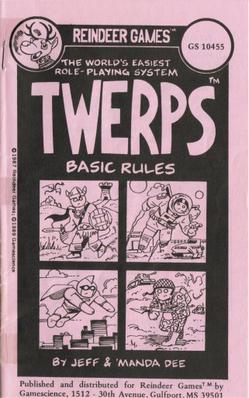
TWERPS is a minimalist role-playing game (RPG) originally created by Reindeer Games in 1987 and distributed by Gamescience. Presented as a parody of the complicated RPG systems which were prevalent at the time while still being a playable game in its own right, its simple structure and humorous nature gave it unexpected popularity.

Ravenloft is a campaign setting for the Dungeons & Dragons roleplaying game. It is an alternate time-space existence known as a pocket dimension or demiplane, called the Demiplane of Dread, which consists of a collection of land pieces called "domains", brought together by a mysterious force known only as the Dark Powers. Each domain is tailored to and mystically ruled by a being called a Darklord who is forever trapped and surrounded by magical mists surrounding the domain. Strahd von Zarovich, a vampire in the original AD&DRavenloft I6 module released in 1983, became the first Darklord, both ruler and prisoner of his own personal domain of Barovia. The story of how Count von Zarovich became Darklord of Barovia was detailed in the 1993 novel I, Strahd: The Memoirs of a Vampire. As originally established in the Ravenloft: Realm of Terror boxed set known as "the Black Box" released in 1990, the Ravenloft campaign setting was located in the Ethereal Plane. As a physical manifestation of that plane, lands, monsters and even people were created out of the mysterious mists, and the realm acted as a prison where one could enter or be transported, but means of escape were few. Other Ravenloft Domains and Darklords were eventually added in various AD&D 2nd edition products establishing a core continent attached around Barovia which could be traveled to by others if their respective lords allowed entering or leaving their borders; while some Domains remained isolated in the mists and were referred to as Islands.

Chill is an investigative and modern horror role-playing game originally published by Pacesetter Ltd in 1984 that captures the feel of 20th-century horror films.
In the Dungeons & Dragons fantasy role-playing game, psionics are a form of supernatural power similar to, but distinct from, arcane and divine magic. Psionics are manifested purely by mental discipline. Psionics were introduced in the original supplement Eldritch Wizardry. Psionics have appeared as part of the core rules beginning with Advanced Dungeons & Dragons 1st edition.
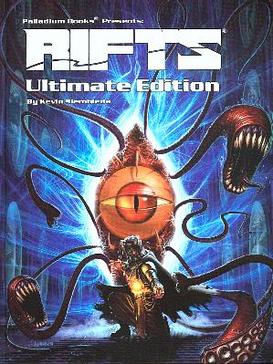
Rifts is a multi-genre role-playing game created by Kevin Siembieda in August 1990 and published continuously by Palladium Books since then. Rifts takes place in a post-apocalyptic future, deriving elements from cyberpunk, science fiction, fantasy, horror, western, mythology and many other genres.

Ravenloft is an adventure module for the Dungeons & Dragons (D&D) fantasy role-playing game. The American game publishing company TSR, Inc. released it as a standalone adventure booklet in 1983 for use with the first edition Advanced Dungeons & Dragons game. It was written by Tracy and Laura Hickman, and includes art by Clyde Caldwell with maps by David Sutherland III. The plot of Ravenloft focuses on the villain Strahd von Zarovich, a vampire who pines for his lost love. Various story elements, including Strahd's motivation and the locations of magical weapons, are randomly determined by drawing cards. The player characters attempt to defeat Strahd and, if successful, the adventure ends.
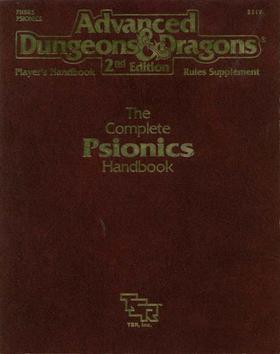
The Complete Psionics Handbook is a supplemental rulebook for the 2nd edition of the Dungeons & Dragons fantasy role-playing game, published in 1991 by TSR, Inc.

The Palladium Fantasy Role-Playing Game is a fantasy role-playing game published by Palladium Books in 1983.
Magic systems in games are the rules, limitations, abilities, and characteristics that define magic in a game.
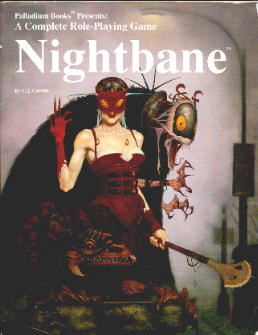
Nightbane is a dark fantasy role-playing game and setting created by C. J. Carella and published by Palladium Books.
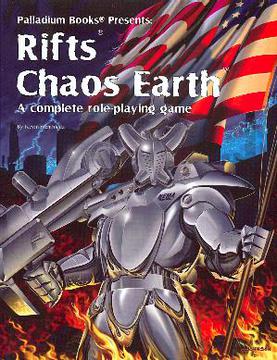
Rifts Chaos Earth is a post-apocalyptic role-playing game from Palladium Books. It is a spinoff and prequel to their popular game Rifts, which uses a similar form of Palladium's Megaversal system.
Psionics, in tabletop role-playing games, is a broad category of fantastic abilities originating from the mind, similar to the psychic abilities that some people claim in reality.
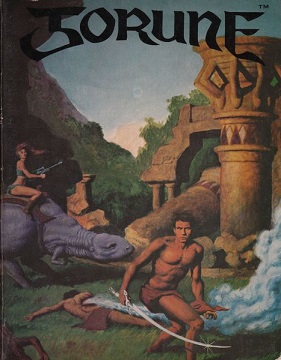
Skyrealms of Jorune is a science-fantasy role-playing game that was first published in 1984 through SkyRealms Publishing. The game is set on the fictional alien planet of Jorune above which float levitating islands. The second edition was published in 1986 as a boxed set, and a third edition was published by Chessex in 1992. The computer game Alien Logic: A Skyrealms of Jorune Adventure was published in 1994. The various editions received positive reviews in game periodicals including Casus Belli, White Dwarf, White Wolf, Different Worlds, Dragon, Polyhedron, The Games Machine, and Challenge.

True20 is a role-playing game system designed by Steve Kenson and published by Green Ronin Publishing. The system was first published as a part of the Blue Rose RPG before being published as a standalone universal generic role-playing game, True20 Adventure Roleplaying.

Conspiracy X is a role-playing game (RPG) originally released by New Millennium Entertainment in 1996, and since revised and released by several publishers including Steve Jackson Games and Eden Studios, Inc. In all versions, the setting posits that aliens are insiduously taking over the world, reminiscent of The X-Files.

Powers & Perils (P&P) is a fantasy role-playing game published by Avalon Hill in 1984. The highly complex game was Avalon Hill's first foray into the role-playing game market, and proved to be a commercial failure.
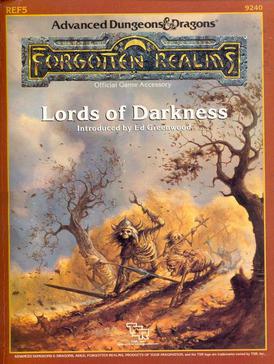
Lords of Darkness is the name of two accessories for the fictional Forgotten Realms campaign setting for the Dungeons & Dragons fantasy role-playing game.

GURPS Horror is a sourcebook for GURPS. The first edition was published in 1987.

Palladium Fantasy RPG Book 3: Adventures on the High Seas is a role-playing game supplement for Palladium Fantasy Role-Playing Game published by Palladium Books in 1987. An updated edition was published in 1996.


















